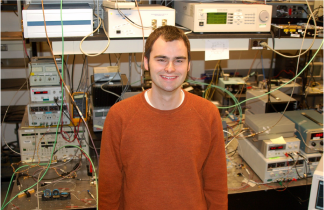
(Prototype of a photonic spark plug using Q-switched Nd:YAG/Cr4+:YAG microlasers (top), and a standard automobile spark plug (bottom). Photo from Takunori Taira, National Institutes of Natural Sciences, Japan)
An April 20, CLEO press release recently caught the eye of the BBC News, and with good reason. A Japanes and Romanian collaboration will show data at CLEO from a 10 mm, multi-beam, ceramic laser whose beams can reach energies greater than 10 millijoules over a 800 picosecond pulse width, to ignite fuel for internal combustion.
The research behind the photonic spark plug will be presented in, CMP1 “Composite All-Ceramics, Passively Q-switched Nd:YAG/Cr4+:YAG Monolithic Micro-Laser with Two-Beam Output for Multi-Point Ignition” on May 2, at 1:30 pm, by Takunuroi Taira and Matsaki Tsunekane from the Laser Research Center in Okazaki, Japan, in collaboration with Kenji Kanehara from Nippon Soken, Inc. in Japan, andNicolaie Pavel of Romania’s National Institute for Laser, Plasma and Radiation Physics in Romania.
There are a handful of advantages to using photonic spark plugs over conventional spark plugs. A photonic spark plug could potentially ignite leaner fuel mixtures (more air and less fuel) to reduce emissions of polluting nitrogen oxides (NOx). Conventional spark plugs cannot practically accomplish this right now because the increased spark-voltage required to ignite lean mixtures erodes the electrodes too quickly-they need to be replaced too frequently which is expensive.
Additionally, a photonic spark plug could improve combustion efficiency for better driving performance and/or fuel economy. A conventional spark plug sits on top of the head of a cylinder and ignites the fuel mixture near the top where there is a large thermal mass of cold metal from the cylinder. Taira's photonic spark plug can focus the beams into the center of the gas mixture for three times faster, and a more symmetric, expansion of the flame. Also, the ignition time-scale using the pulsed micro-laser beams is nanoseconds compared to milliseconds for a conventional spark plug. The ability to better control ignition timing over an automobile's cylinders will result in more power delivered to the drive-train when desired.
The Japanese and Romanian collaboration is already working with DENSO Corporation, an affiliate of Toyota. Keep your eyes out for photonic, fiber-patch cord jumper cables in the near future!

No comments:
Post a Comment